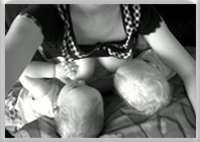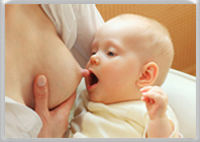Breastfeeding Positions Basics

Knowing and understanding breastfeeding positions basics is essential to your breastfeeding success.
- Together with a poor latch, incorrect positioning may lead to certain breastfeeding problems, like sore nipples, engorgement, milk blisters, clogged milk ducts, or even mastitis. Visit Breastfeeding Problems section for more info.
- Incorrect positioning may also cause low milk supply.
- Consistently placing your baby in an uncomfortable position may discourage him/her from breastfeeding and lead to a nursing strike.
You will spend most of your first postpartum year breastfeeding. Let’s make sure it is pleasant and comfortable for both you and your baby.
Whatever breastfeeding position your baby chooses, the following techniques will be useful:
- Unless your breasts are larger in size and heavier, you shouldn’t need to support them during the entire feeding. You can hold your breast shortly in the beginning to help your baby latch-on. Holding your breast all the time may lead to an uneven emptying of the milk ducts and may clog them.
- If you have larger size breasts and it makes it difficult for the baby to latch on, roll a piece of clothing and place it under the breast.
- If your baby doesn’t mind, alternate breastfeeding positions. This ensures better emptying of the breasts, prevents and treats clogged milk ducts and minimizes nipple soreness.
- Support your baby well during the feeding. It gives your baby re-assurance that he/she is doing the right thing. It also ensures that the baby remains in the correct position throughout the feeding.
- Whatever position your baby chooses, make sure his/her body remains in a straight line.
- Your baby’s head shouldn’t be raised or dropped, as it makes milk swallowing difficult and tenses the neck.
- You need to make yourself comfortable and relaxed too. Tensed body releases less milk. Use nursing pillows, footstools or a blanket as needed.
- Ensure you baby’s proper latch-on.
- In any position don’t allow your baby pulling on your nipple. Bring your baby closer to the breast.
- If possible undress your baby for the feedings. Skin contact adds to the positive breastfeeding experience.
- Try to keep your baby as close to your body as possible. This ensures proper latch-on and increases skin contact. This way your baby may also hear your heartbeat, which is the most desirable and assuring sound for your little one.
- If you are breastfeeding twins, breastfeed them separately until
breastfeeding stabilizes. When you feel confident, breastfeed them
simultaneously in a football or cradle position. Find out more here.
- Check your position and posture. You need to be relaxed during the feeding and not have to lean, turn, bend or hold your arms in a tensed position.
- To manage your oversupply, place your baby so that his/her mouth and head are higher than the level of your nipple. Fluids have more difficulty flowing upwards and your milk flow will slow down.
- You may need to modify standard breastfeeding holds to fit a baby with special needs, like cleft lip, cleft palate, or tongue-tied babies.
Breastfeeding positions basics are all about making you and your baby comfortable. You both have the right to enjoy the process!
Now let's get to the discussion of various breastfeeding positions.
Home › Positions Basics













